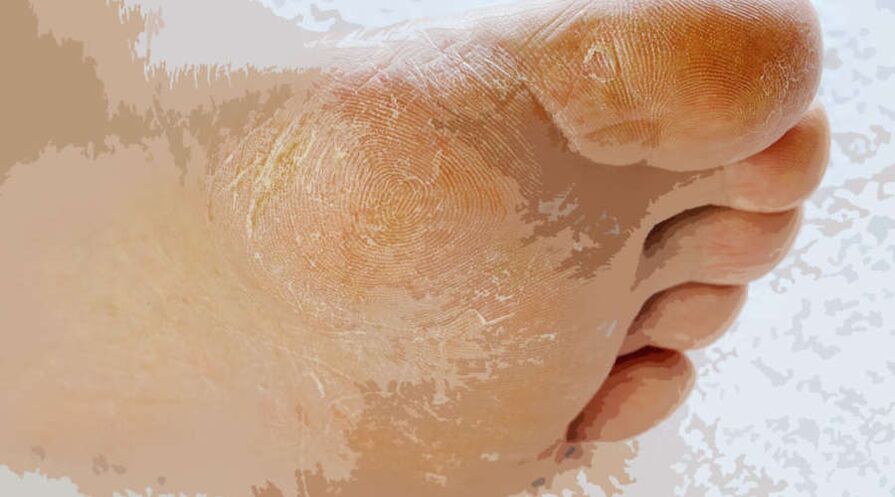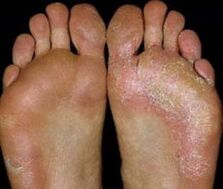
Foot fungus (ICD code 10 B35. 3) is a fungal infection of the skin on the feet caused by parasitic dermatophytes. It occurs in about 20% of adults. Infection occurs through microtrauma, scratches, abrasions, wounds. The development of the disease is promoted by wet feet, diabetes and weakened immunity.
Among people with endocrine disorders, immunodeficiency conditions, the prevalence reaches 50%. Most often, the disease progresses to a chronic form with alternating periods of remission and exacerbations. In 40-50% of cases, foot fungus causes onychomycosis or fungal infection of the nails.
Where and why does the infection occur?
Foot fungus is a contagious disease that is easily transmitted through direct contact with a vector of the fungus or through household items. For example, with shoes, socks, towel, manicure items, rubber mats in the shower. In 70-95% of cases, the causative agent of foot fungus is Trichophyton red (Tr. Rubrum).
Infection usually occurs in public places with high humidity, where there are favorable conditions for the reproduction and spread of the pathogen. Such areas include swimming pools, public showers, saunas, water parks, gyms. If a person infected with the fungus walks barefoot on the floor or rugs in the shower, they will leave the infectious particles behind. And if then a healthy person enters this place barefoot, then the pathogen will fall on his skin. In this case, the fungus does not always manifest immediately and causes the characteristic symptoms of the disease. With strong immunity, in the absence of health problems, a person remains simply a carrier of the infection, but at the same time does not get sick.
Increased risks of fungus and the development of fungal infections of the feet:
- damage to skin integrity.
- Violation of the blood supply to the extremities, where the supply of oxygen and nutrients to the tissues deteriorates, regenerative processes slow down, local immunity weakens.
- Diabetes mellitus, high blood glucose levels create favorable conditions for the growth of the fungus, the progression of the infection.
- excessive sweating?
- dry skin, which leads to micro-alloys.
- old age?
- blood diseases?
- long-term use of antibiotics, drugs that suppress immunity.
- vitamin deficiency?
- Wear shoes that are air permeable and create a "greenhouse effect".
Symptoms and types of the disease

Foot fungi manifest in different ways, the type of pathogen and the severity of the lesion affect the symptoms. The first signs of the disease appear in the folds between the toes and from there they spread to the soles of the feet, sides, back and nails.
The appearance of fungal feet is shown in the photo.
When nails become infected, there is thickening, loss of gloss, blurring of the plaque. The nail acquires a yellow, gray hue, becomes brittle, collapses. Early clinical symptoms of toenail fungus include dryness, flaking of the skin, and painless cracks in the folds between the toes. This form of the disease is called deletion. Peeling and cracking at first do not cause pain, itching or discomfort. Only a doctor can notice the first unexpressed signs of a fungal infection. In addition to the extinct, there are other clinical forms of foot fungus, each of which has its own symptoms.
Squamous
In the squamous form of foot fungus, it flakes in the folds between the toes and the ribs. As a rule, there are no signs of inflammation. It is possible redness, damage to the nails, itching, thickening of the stratum corneum, which gives radiance to the skin. The papillary lines become more intense and the surface of the skin becomes dry, covered with leafy scales. In this case, the patient does not feel itching or other unpleasant sensations.
Hyperkeratotic
Appears as a rash on the treasuries. The surface of the rash elements is covered with layers of gray-white scale. There is a detachment of the skin, the simple vesicles. When fused together, the rash forms indistinctly large foci that extend across the sole, including the lateral, dorsal surfaces. Along with flaking spots, there are areas of hyperkeratosis or thickening of the skin. They look like calluses with cracks at the top. With a hyperkeratotic form of foot fungus, the affected area is similar to the manifestations of psoriasis or eczema. A person worries about dryness, itching and sometimes pain.
Intertriginous
The endogenous form of foot fungus is similar to the symptoms of a diaper rash. Hence the name from lat. intertrigo - "diaper rash". Most often, the skin is affected in the intervals between the third and fourth, fourth and fifth finger. It becomes bright red, swollen. Wounds form, deep, painful cracks. In contrast to the diaper rash, the lesions in endogenous fungal infections are round with clear outlines, with a white outline separating along the edges of the skin. The person experiences itching, burning, pain. Dyshidrotic
Dyshydrotic forms of foot fungus are characterized by multiple vesicles with a dense apex, located mainly in the arches. The rash spreads to large areas of the soles, as well as to the areas between the feet and the skin of the toes. Merge to form large bubbles. In place of the explosive bubble, liquid corrosion occurs. As the inflammation develops, the skin becomes red and swollen. At the stage of vesicle formation, the patient feels unbearable itching.
Diagnostics
If you suspect foot fungus, you should see a dermatologist. To confirm the diagnosis, the doctor will examine the feet, ask about the symptoms that bother the person, how long before and after which they appeared. Scrape the affected area for microscopic analysis, cultural research to identify a specific type of pathogen. In addition, your doctor may order blood tests.
How to deal with foot fungus?
Mycologist or dermatologist treats fungal infections of the skin of the feet. Taking into account the clinical form of the disease, the severity of the lesion, the visible changes, the doctor will choose an appropriate treatment.
Complications of a fungal infection of the feet can lead to a fungal infection of the hands. Fungal infections of the feet can sometimes lead to secondary bacterial infections, especially when there are sores on the skin.
External fungicides (ointments, creams), tablets for oral administration are prescribed to fight the fungus. Only topical treatment is effective for mild forms of foot fungus. According to clinical guidelines, oral medications are prescribed in severe cases.
If necessary, treatment is supplemented with anti-inflammatory, drying, antiseptic, anti-allergic drugs, agents that enhance the regeneration of damaged tissues. If there is evidence of bacterial infection, antibiotic treatment is prescribed.
Onychomycosis cleans the material of areas infected with the fungus. For the subsequent treatment of the nails, local antifungal agents are prescribed: varnish, cream or ointment.
The duration of treatment is from two weeks to one month. If not only the skin but also the nails are affected, the treatment is delayed. This is due to the fact that the nail grows slowly. To get rid of the infection, it is necessary to re-grow a completely healthy nail plate.
When the doctor's prescriptions are followed, the fungus can be successfully treated. But if, noticing an improvement, the patient stops taking medication, it leads to a return of the infection, a transition to a chronic form. It is necessary to complete the full course, even if the symptoms of the disease have already disappeared.
Very important in the treatment of fungal infections: foot care, personal hygiene, nutrition, choosing comfortable shoes that do not injure the affected areas.
What do you need to do to prevent it?
To prevent fungal infections of the feet and nails or to reduce the risk of developing them, the following recommendations will help: the limbs weaken or the body's defenses are weakened.
If you find even slight peeling of the skin on your feet or cracks between your toes, it is worth trying for fungus. Early diagnosis and early treatment will help you avoid complications, extensive damage, discomfort, walking pain and bacterial infection.





























